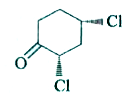Which of the following compounds do not have the plane of symmetry?




The correct Answer is:B, C, D
Step by step video, text & image solution for Which of the following compounds do not have the plane of symmetry? by Chemistry experts to help you in doubts & scoring excellent marks in Class 12 exams.
Similar Questions
Which of the following compounds have the plane of symmetry?
View SolutionWhich of the following compounds does not contain the plane of symmetry ?
View SolutionA line which bisects a compound in two equal parts and both parts appear to be the mirror image of each other, such kind of symmetry is known as plane of symmetry.
Any molecule that has a internal mirror plane of symmetry cannot be chiral, even though it may contain asymmetric carbon atoms.

Which of the following compounds does not contain plane of symmetry?View SolutionWhich of the following gland do not have duct?
View SolutionWhich of the following gland do not have duct?
View SolutionWhich of the following groups do not have the antennae?
View SolutionWhich of the following compound does not have isolated diene
View SolutionWhich of the following compounds do not have all C-C bonds of same length?
View SolutionWhich of the following compounds does not have an ester linkage ?
View SolutionWhich of the following compound has plane of symmetry ?
R=−CH∣CH3−CH S=−CH∣Br−ClView Solution


